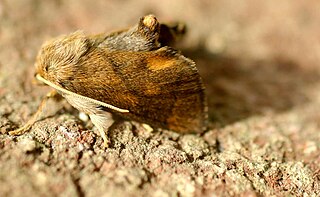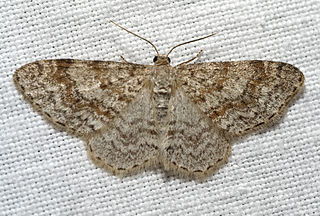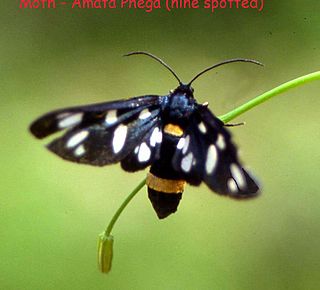
The flannel moths or crinkled flannel moths are a family of insects. They occur in North America and the New World tropics. The larvae are called puss caterpillars, and with their long hairs, resemble cotton balls. They have venomous spines that can cause a painful sting and inflammation lasting for several days. In some cases, the sting may cause headache, nausea, and shock-like symptoms. Perhaps the most notorious for stinging is the caterpillar of Megalopyge opercularis.

The Drepanidae is a family of moths with about 660 species described worldwide. They are generally divided in three subfamilies which share the same type of hearing organ. Thyatirinae, previously often placed in their own family, bear a superficial resemblance to Noctuidae. Many species in the Drepanid family have a distinctively hook-shaped apex to the forewing, leading to their common name of hook-tips.

The Limacodidae or Eucleidae are a family of moths in the superfamily Zygaenoidea or the Cossoidea; the placement is in dispute. They are often called slug moths because their caterpillars bear a distinct resemblance to slugs. They are also called cup moths because of the shape of their cocoons.

Callidulidae, the only known family of the superfamily Calliduloidea, is the family of Old World butterfly-moths, containing eight genera. They have a peculiar distribution, restricted to the Old World tropics of South East Asia to Australasia and Madagascar. The three subfamilies exhibit both day- and night-flying behaviour.

Ugia is a genus of moths in the family Erebidae erected by Francis Walker in 1858.

Asthenini is a tribe of geometer moths under subfamily Larentiinae first described by Warren in 1893. The tribe has been combined with Eupitheciini in the past, most notably by Jeremy Daniel Holloway in his work The Moths of Borneo.

Lymantriini is a tribe of moths of the family Erebidae. This tribe is a group of polyphagous moths that reside mostly in the tropical regions of Afro-Eurasia but also North America.

Caeneressa diaphana is a moth in the family Erebidae first described by Vincenz Kollar in 1844. It is found from India to southern China, Taiwan and Sundaland.

Caeneressa marcescoides is a moth in the family Erebidae. It is found in Borneo, Papua New Guinea and Thailand.
The Catephiini are a tribe of moths in the family Erebidae.
Caeneressa annosa is a moth of the family Erebidae. It was described by Francis Walker in 1859. It is found on Borneo, the Natuna Islands, Sumatra and Peninsular Malaysia.
Caeneressa brithyris is a moth of the family Erebidae. It was described by Herbert Druce in 1898. It is found on Borneo and Sumatra.
Caeneressa everetti is a moth of the family Erebidae. It was described by Rothschild in 1910. It is found on Borneo and the Natuna Islands. The habitat consists of lowland forests, including alluvial forests.
Caeneressa longipennis is a moth of the family Erebidae. It was described by Francis Walker in 1862. It is found on Borneo. The habitat consists of lowland areas.
Caeneressa lutosa is a moth of the family Erebidae. It was described by Jeremy Daniel Holloway in 1976. It is found on Borneo.
Caeneressa robusta is a moth of the family Erebidae. It was described by Jeremy Daniel Holloway in 1976. It is found on Borneo.
Caeneressa sexpuncta is a moth of the family Erebidae. It was described by Rothschild in 1912. It is found on Borneo. The habitat consists of lowland forests.
Caeneressa syntomoides is a moth of the family Erebidae. It was described by Rothschild in 1912. It is found on Borneo. The habitat consists of lowland forests.

The Syntomini are a tribe of moths in the family Erebidae. The tribe was erected by Gottlieb August Wilhelm Herrich-Schäffer in 1846.
Caeneressa tienmushana is a species of moth in the family Erebidae. It was described by Obraztsov in 1957. It is found in China.









